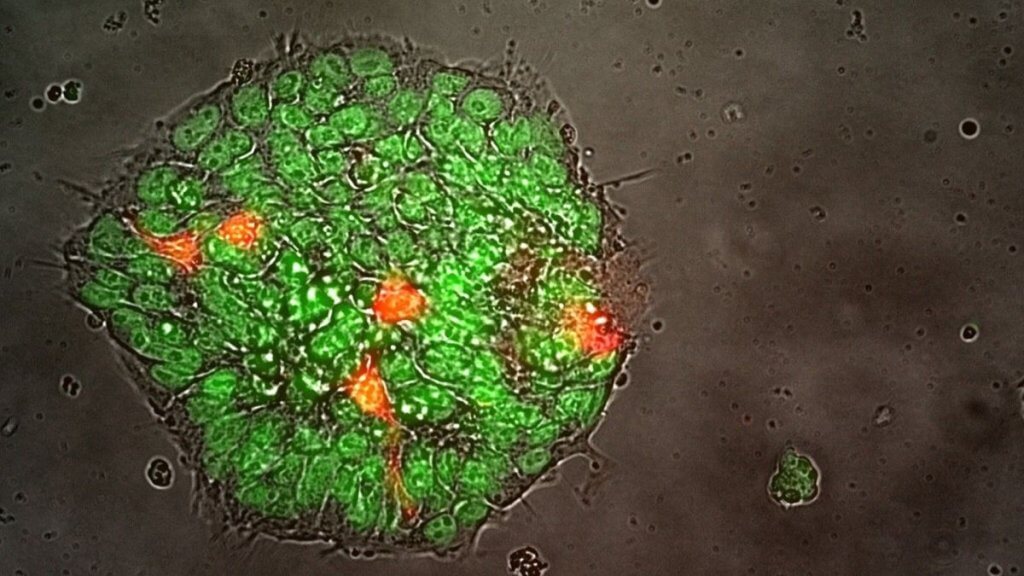
SpaceX Ax-2 private astronaut mission will grow 1st stem cells in space (Image Credit: Space.com)
Scientists will send stem cells to space in early May to investigate the effect of weak gravity or “microgravity” in space on stem cells.
The induced pluripotent stem cells (iPSCs), a type of stem cell that can develop into the three primary groups of cells that make up a human body, will be cultivated in space by astronauts aboard the International Space Station (ISS) by astronauts flying on Axiom Space’s private Ax-2 mission. The mission is scheduled to launch aboard a SpaceX Falcon 9 rocket no earlier than 5:37 p.m. EDT (2137 GMT) on May 21 from Kennedy Space Center in Florida.
Growing these cells and allowing them to differentiate in space should allow researchers to determine if microgravity has any impact on the way iPSCs develop into other cell types like brain and heart cells.
Related: SpaceX to launch 1st Saudi woman to space on private Ax-2 mission
“A major challenge for using iPSCs for therapies in humans is making enough of them at very high quality,” research co-leader and Cedars-Sinai cell biologist Arun Sharma, said in a statement. (opens in new tab) “We want to be able to mass-produce them by the billions so that we can utilize them for a number of different applications, including discovering new drugs that may be able to improve heart function. And while we’ve gotten better at this over the last few years, there are still certain limitations when it comes to the production of these stem cells, and we think microgravity may be able to overcome some of these.”
An iPSC is a powerful type of cell, according to Cedars-Sinai, that has been reprogrammed from an adult cell to return to a state called “pluripotency.” While in this state, the cell can be turned into nearly any cell type found in the human body. This makes iPSCs important in creating models of diseases and for creating specifically tailored treatments.
Producing iPSCs on Earth is tricky, however, partially because of the gravitational effects of the planet which can restrict the expansion and growth of these cells. In low-gravity environments, like that of the ISS which orbits Earth at an altitude of around 253 miles (408 miles), this barrier could be removed.
“Gravity constantly pulls these pluripotent stem cells towards Earth, putting pressure on them and providing a stimulus to start turning into other cell types, but in microgravity, that effect will no longer be there,” mission co-principle investigator and executive director of the Cedars-Sinai Board of Governors Regenerative Medicine Institute, Clive Svendsen said in the statement. By removing gravity from the equation, researchers will be able test whether or not cells grow faster in space, present fewer genetic mutations and remain in their versatile pluripotent state. “That is the goal of this new mission, and we are all very excited to see what happens up there,” Svendsen said.
A Cedars-Sinai team will arrive at Kennedy Space Center a week before launch to prepare the stem cells and load them onto a Dragon spacecraft. The Ax-2 crew will then launch in the Dragon craft atop a SpaceX Falcon 9 rocket no sooner than May 21, if all goes according to plain.
The mission will last just a week but sets the stage for future missions of longer duration over the coming months that will further test the ability of stem cells to divide and take up DNA during spaceflight.
Axiom Space is a private astronaut training and mission management provider based in Houston, Texas, home of NASA’s Johnson Space Center. The company aims to “provide universal access to low Earth orbit so that innovators, governments and individuals can do the same,” the company’s website reads (opens in new tab).
Ax-2 will be the second mission that Axiom Space has organized and operated aboard the ISS. The first, Ax-1, launched atop a SpaceX Falcon 9 in April 2022 and sent four private astronauts to the orbital lab for over two weeks. It was the first all-private astronaut mission to the International Space Station.
Axiom is also working on several space station modules of their own that will launch to the ISS in the years to come. These will eventually detach from the soon-to-be-defunct International Space Station to become their own private space research facility in low Earth orbit.





